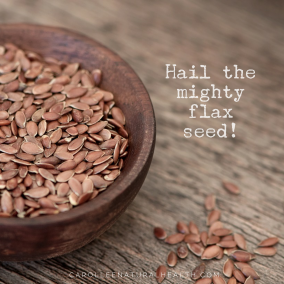
Flax, also known as Linseed, is something I eat everyday in various ways, it is super cheap and really nutritious. If you want to use it widely then you will need to get a small coffee grinder as the hard seeds take some cracking.
Nutrients
- Flax is super rich in omega 3 oils, these are the good anti-inflammatory essential fatty acids. They are called essential because they are necessary for every function that happens in the body and are an integral part of each and every cell membrane of our 70 trillion cells.
- Flax is rich in lignin or plant-oestrogens and have been well known to support women through hormonal changes of the menopause and help reduce hot flushes.
Here is a breakdown of the nutrients in flax...
One tablespoon of ground flaxseeds contains the following:
Calories: 37
Protein: 1.3 grams
Carbs: 2 grams
Fibre: 1.9 grams
Total fat: 3 grams
Saturated fat: 0.3 grams
Monounsaturated fat: 0.5 grams
Polyunsaturated fat: 2.0 grams
Omega-3 fatty acids: 1,597 mg
Vitamin B1: 8% of the RDI
Vitamin B6: 2% of the RDI
Folate: 2% of the RDI
Calcium: 2% of the RDI
Iron: 2% of the RDI
Magnesium: 7% of the RDI
Phosphorus: 4% of the RDI
Potassium: 2% of the RDI
Flax always needs some kind of low level processing before we can eat and digest it so we can the most nutrients out of it. Flax has a very tough shell and if we eat them as they are, they come out the other end completely intact!
So you can either:
- Grind in a coffee mill, the extra power is needed believe me. Fresh is best but if you can’t use straight away or want to do a batch, then store in a glass jar is the fridge. The oils go rancid very rapidly so the cold and dark will slow this down.
- Soak overnight. Simply put a teaspoon of the whole seed in a bowl and cover with water, a twelve hour soak is good.
- Boil in water, this softens the shell and encourages the oils and lignans to be released. Either of these break the shell and release the amazing nutrients inside
How to use flax
- Make a flax/linseed tea from the boiled flax seed; this has a sweet nutty taste. It can be drunk as it is but I suggest diluting it with hot water to thin it down. The lignans are wonderful food for the healthy bacteria in the gut. It also helps our gut hold onto water, helping us pass fuller stools and so helping to combat constipation.
- You can use ground flax to sprinkle on salads and soups or anything that needs a garnish.
- You can use ground flax as a replacement for an egg in cooking. The basic ratio is one tablespoon of flax seeds and three tablespoons of water to replace one egg. The natural stickiness of the ground flax will help bind food together.
- You can add ground flax to porridge or soaked oats to really bulk out a meal as well as give you a pile of extra nutrition. Flax naturally absorbs water so let your porridge stand for a while and you may need to add extra water. Start by grinding approximately 1 teaspoon.
- Soaked flax can be used as an effective remedy for constipation, soak the seeds overnight and then ‘drink’ the seeds with the soak water or add into porridge/soaked oats. If you have a tendency towards constipation this is a better way that adding ground seeds as the ‘message’ from the seeds is one of full hydration.
- Make a standard salad dressing (3 parts oil, one part vinegar) with flax oil instead of olive oil, you could even replace balsamic vinegar with raw cider vinegar. Remember to keep the glass bottle or jar in the fridge
